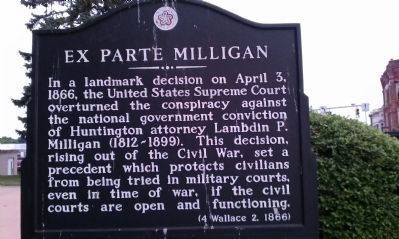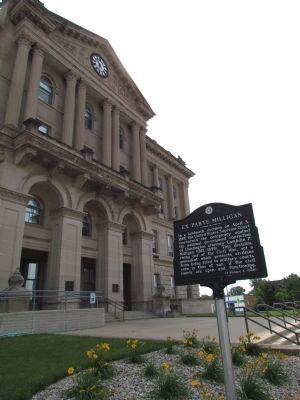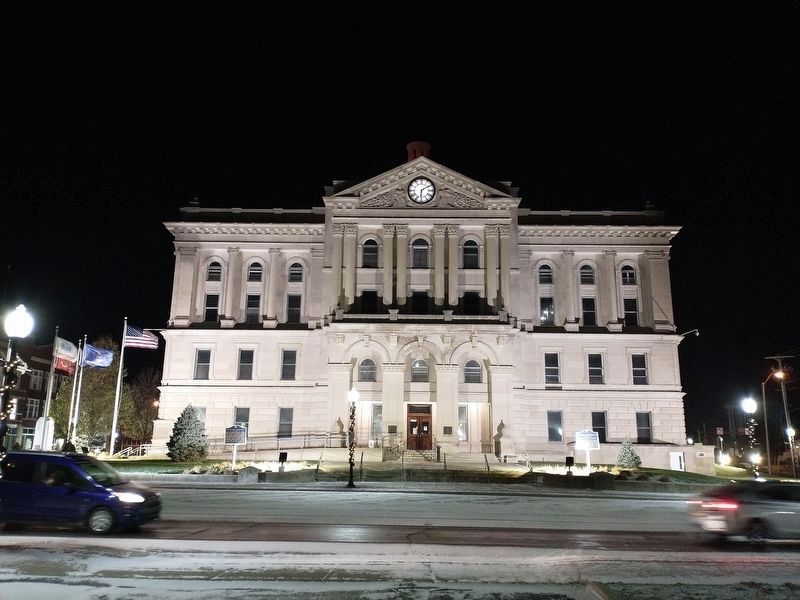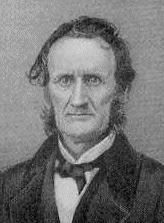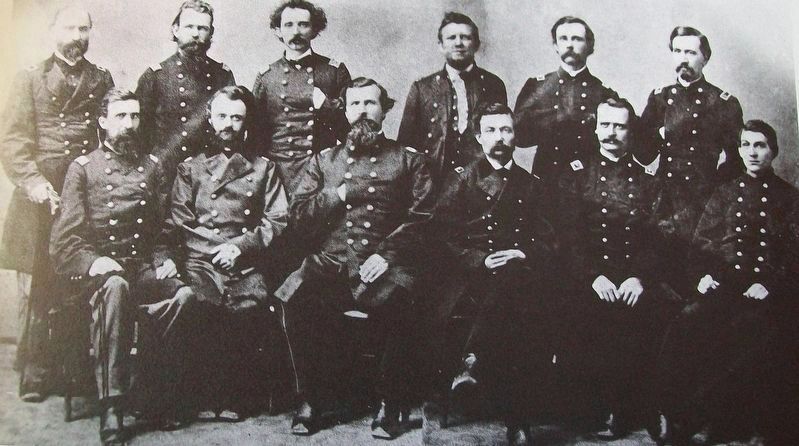Huntington in Huntington County, Indiana — The American Midwest (Great Lakes)
Ex Parte Milligan
Erected by American Revolution Bicentennial 1776-1976.
Topics and series. This historical marker is listed in this topic list: Civil Rights. In addition, it is included in the The Spirit of ’76, America’s Bicentennial Celebration series list. A significant historical date for this entry is April 3, 1866.
Location. 40° 52.861′ N, 85° 29.633′ W. Marker is in Huntington, Indiana, in Huntington County. Marker is on Jefferson St., 0 miles north of State St., on the left when traveling south. This marker is located on the West lawn of the Huntington County Courthouse, North of the steps. Touch for map. Marker is in this post office area: Huntington IN 46750, United States of America. Touch for directions.
Other nearby markers. At least 8 other markers are within walking distance of this marker. Huntington County War Memorial (a few steps from this marker); In Memory of Huntington County Boys, who lost their lives in the World War. (a few steps from this marker); The Huntington County Courthouse (a few steps from this marker); Samuel Huntington (within shouting distance of this marker); James Danforth Quayle (within shouting distance of this marker); Dr. Otto U. King, 1873-1951 / Otto U. King, D.D.S, F.A.C.D. (within shouting distance of this marker); Moore-Carlew Building (about 500 feet away, measured in a direct line); Huntington's Ford and First Bridge / Huntington's Buildings Over the River (about 700 feet away). Touch for a list and map of all markers in Huntington.
Also see . . . Ex Parte Milligan - Wikipedia. “Ex parte Milligan was a U.S. Supreme Court case that ruled the application of military tribunals to citizens when civilian courts are still operating is unconstitutional. In this particular case the Court was unwilling to give President Abraham Lincoln's administration the power of military commission jurisdiction, part of the administration’s controversial plan to deal with Union dissenters during the American Civil War. Justice David Davis, who delivered the majority opinion, stated that ‘martial rule can never exist when the courts are open’ and confined martial
law to areas of ‘military operations, where war really prevails,’ and when it was a necessity to provide a substitute for a civil authority that had been overthrown.” (Submitted on July 25, 2011, by Bill Pfingsten of Bel Air, Maryland.)
Credits. This page was last revised on December 3, 2022. It was originally submitted on July 20, 2011, by Willard McKinzie of Huntington, Indiana. This page has been viewed 1,451 times since then and 26 times this year. Last updated on January 16, 2014, by Willard McKinzie of Huntington, Indiana. It was the Marker of the Week April 1, 2018. Photos: 1. submitted on July 20, 2011, by Willard McKinzie of Huntington, Indiana. 2. submitted on June 13, 2022, by Trevor L Whited of Kokomo, Indiana. 3. submitted on January 26, 2014, by Duane Hall of Abilene, Texas. 4. submitted on November 21, 2022, by Tom Bosse of Jefferson City, Tennessee. 5. submitted on March 31, 2018, by J. J. Prats of Powell, Ohio. 6. submitted on January 2, 2019, by Willard McKinzie of Huntington, Indiana. • Bill Pfingsten was the editor who published this page.
